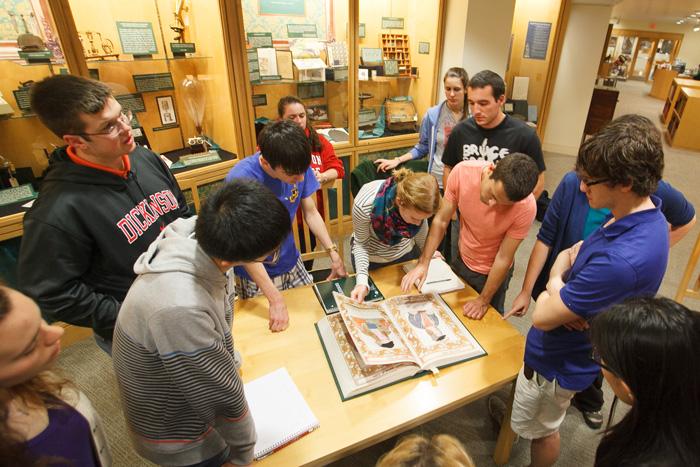The Closest Thing to a Time Machine

Students often find themselves in the lower level of the Waidner-Spahr Library, leafing through source material to supplement coursework. Photo by Carl Socolow '77.
Students touch physical history in Dickinson’s Archives & Special Collections
by Tony Moore
You might think of archives as dark rooms, usually in basements, that smell like 100-year-old binding glue, yellowed paper and historic significance. The collections—books, art, ephemera—are sealed behind glass or stored in protective sleeves, and they’ll shatter if you touch them, will melt if the oils from human fingers violate their delicate constitutions. In other words, visitors need to keep their distance, or else.
But this isn’t the case with Dickinson’s Archives & Special Collections.
What’s old is new again
“The first day of class in the archives, I said, ‘We have a first edition [fourth printing, 1668] of Paradise Lost,’ ” says Carol Ann Johnston, professor of English, who teaches a course each year on John Milton. “And one of the students teared up a little and said, ‘You’re kidding.’ I said, ‘No, it’s right here,’ and I pulled it out, and she was like, ‘Can we touch it?’ ”
And yes, they could touch it. Because, as Johnston says, “We have the ethos that books are not in an archive to collect dust; they’re there for teaching purposes.” And that’s been the case at Dickinson since the 1970s, when history students immersed themselves in the collections to research aspects of the college’s past. Now, ironically, the Internet—with its vast storehouse of information at the ready—has made many turn back to physical objects and original source documents to experience history on a different level.
“We are bombarded with transient digital information on two-dimensional screens,” says Malinda Triller Doran, special collections librarian, noting that students are finding a new appreciation for tangible objects that can stimulate both the mind and the senses. “Many students comment on how awe inspiring it is to hold a document in their hands that was written by a noteworthy figure, such as Martin Luther King Jr., Marianne Moore or Benjamin Rush.”
For Johnston, it’s the physical contact with such works, that particular sensory experience, that makes the archives a unique resource.
“Being in the archives lets you come at the words on the page in a much more holistic way,” she says, noting that she’ll use the archives again in the spring for her Visual Poetry course. “Being in the archive, to me, is the closest thing we can come to getting in a time machine, because we have the most important artifacts, outside of the original manuscripts. I’ve always been a believer in trying to engage more of the senses in thinking about reading, and this is a great way to do that.”
A history within a history
Julia Williams ’18 (English) took Johnston’s Revolutionary Milton course in the fall and gave a presentation on the Doves Press (1905) edition of Samson Agonistes, which was appended to Paradise Regained. Through the archives, Williams explored the physical process of the book’s publication, and she found that the archives led her to the history of Milton’s evolving standing as a literary figure as well, something she says “would have been lost if we just stuck to the textbook.”
“There’s more to a book than just its words, especially in the case of Milton,” says Williams, who found the author’s literary status mapped out through how his books were published. For example, when he was considered a taboo author, one of his books was very small [in size], with little to no indication of authorship. “In others, it was done so artfully and with such craftsmanship, in a time when books were being mass produced, that it spoke to how important his text was to the publishers.”
Something for everyone
Of course, there’s more to what’s housed in the lower level of the Waidner-Spahr Library than Milton, and faculty members across the academic spectrum frequently use the archives, enhancing such classes as Assistant Professor of German Antje Pfannkuchen’s First-Year Seminar, The Image of Objectivity: Critical Approaches to the History of Science, and Associate Professor of Physics & Astronomy Windsor Morgan’s Time and the Past, Present and Future.
“Our collections cover a wide variety of topics and represent many formats, including rare books, letters, diaries, three-dimensional objects, images of different types and audiovisual materials,” explains Triller Doran. “We can support instruction in just about any subject taught at Dickinson—American studies, art & art history, French, theatre & dance and women’s & gender studies, just to name a few.”
The experience students have with source materials makes the lessons come alive, and Triller Doran welcomes the excitement generated, in what might be an otherwise quiet setting.
“The students get so wrapped up in what they’re exploring that they call their classmates over to see what they have, and you hear shouts of ‘Look at this!’ or ‘Let me read this to you,’ ” she says. “It’s not necessary to sit still and be quiet in the archives. Discovery is an active process.”
Learn more
Published January 19, 2016